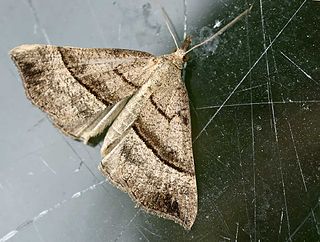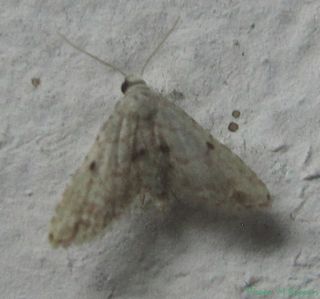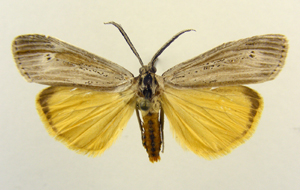
The Lymantriinae are a subfamily of moths of the family Erebidae. The taxon was erected by George Hampson in 1893.

Noctuoidea is the superfamily of noctuid or "owlet" moths, and has more than 70,000 described species, the largest number of any Lepidopteran superfamily. Its classification has not yet reached a satisfactory or stable state. Since the end of the 20th century, increasing availability of molecular phylogenetic data for this hugely successful radiation has led to several competing proposals for a taxonomic arrangement that correctly represents the relationships between the major lineages.

The Ophiusini are a tribe of moths in the family Erebidae.

The Hypeninae are a subfamily of moths in the family Erebidae. The taxon was first described by Gottlieb August Wilhelm Herrich-Schäffer in 1851. A notable species is Mecistoptera griseifusa, which lives solely on tears it drinks with its proboscis.
Phlyctaenogastra is a genus of moths in the family Erebidae erected by Max Gaede in 1915.

Idia is a genus of litter moths of the family Erebidae first described by Jacob Hübner in 1813.

Araeopteron is a genus of moths of the family Erebidae. The genus was erected by George Hampson in 1893.

Zanclognatha is a genus of litter moths of the family Erebidae. The genus was erected by Julius Lederer in 1857.

Parascotia is a genus of moths of the family Erebidae. The genus was erected by Jacob Hübner in 1825.

The Erebinae are a subfamily of moths in the family Erebidae erected by William Elford Leach in 1815. Erebine moths are found on all continents except Antarctica, but reach their greatest diversity in the tropics. While the exact number of species belonging to the Erebinae is not known, the subfamily is estimated to include around 10,000 species. Some well-known Erebinae include underwing moths (Catocala) and witch moths (Thermesiini). Many of the species in the subfamily have medium to large wingspans, up to nearly 30 cm in the white witch moth, which has the widest wingspan of all Lepidoptera. Erebine caterpillars feed on a broad range of plants; many species feed on grasses and legumes, and a few are pests of castor bean, sugarcane, rice, as well as pistachios and blackberries.
The Micronoctuini are a tribe of moths in the family Erebidae that includes about 400 described species. Typical species in the tribe have bifine hindwing venation and are smaller than those in other noctuoid moths. Micronoctua karsholti is the smallest of all species in the superfamily Noctuoidea.

Afrocoscinia is a curious genus of tiger moths in the family Erebidae erected by Vladimir Viktorovitch Dubatolov in 2011. The genus includes only one species, Afrocoscinia aethiopica, described by Lars Kühne in 2010, which is found in the arid regions of the western part of South Africa. By the general appearance of wing and body shape, it looks like species of the Palearctic genus Coscinia from Callimorphina. But many other characteristics of this moth show that is it a member of the Nyctemerina.

Pandesma muricolor is a moth of the family Erebidae. It is native to western, central & south-eastern Africa.

The Boletobiinae are a subfamily of moths in the family Erebidae, containing about 956 species. The taxon was described by Achille Guenée in 1858.

The Rivulinae are a subfamily of moths in the family Erebidae described by Augustus Radcliffe Grote in 1895. Caterpillars in the subfamily typically have long, barbed hairs and have full prolegs on abdominal segments 3 through 6. The adults have a unique microsculpturing proboscis.

The Scolecocampinae are a subfamily of moths in the family Erebidae. The taxon was erected by Augustus Radcliffe Grote in 1883.
The Toxocampinae are a subfamily of moths in the family Erebidae. Moths in the subfamily typically have a primitive form of genital claspers similar to those of some subfamilies of the Noctuidae.
The Audeini are a tribe of moths in the family Erebidae.

The Euclidiini are a tribe of moths in the family Erebidae. The tribe was erected by Achille Guenée in 1852.
Acantholipes canofusca is a species of moth in the family Erebidae first described by Hermann Heinrich Hacker and Aidas Saldaitis in 2010. It is found on Socotra, an island off Yemen.















